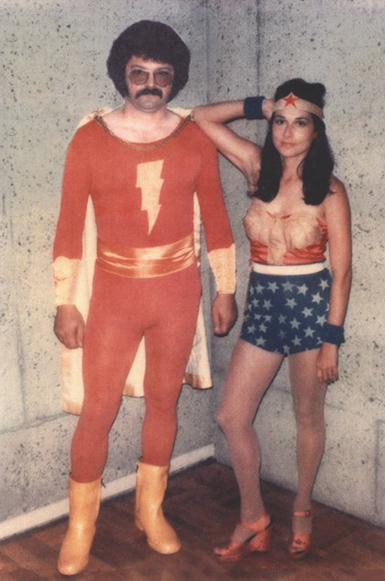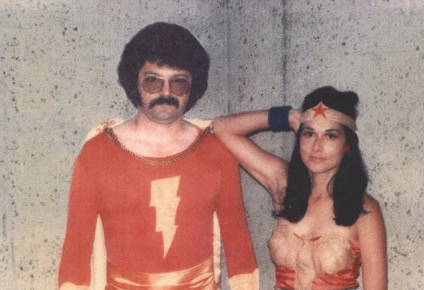[ad_1]

Mel Ramos with Leda, a frequent model for the artist’s work.
COURTESY LOUIS K. MEISEL GALLERY
Mel Ramos, whose paintings of pinup models occupy an unusual space in the history of Pop art, has died at 83. A story in the San Francisco Chronicle, which first reported the news yesterday, cited heart failure as the cause.
Ramos’s treatment of his subject matter—oftentimes naked women posed suggestively with consumer products—has been both lauded and called into question. His style has been appraised as a statement on the misogyny inherent in advertising and pictures that are sexist themselves. Similarly, his paintings of superheroes, historical nudes, and palm trees have been considered commentaries on “low” imagery and disparaged as kitsch. (A show of his paintings of female superheroes, many of them posed in front of comic book–like text bearing their names, is currently on view at Louis K. Meisel Gallery in New York.)
His most iconic work remains his paintings of pinup models, who appear almost always appear partially or fully naked in his work. Set against monochromatic backgrounds, the figures rise out of candy wrappers, suggestively hold Chiquita bananas, lean against giant Coca-Cola bottles, peer out behind oversized cigars, and lie like odalisques on much-larger-than-family-sized Tootsie Rolls. The imagery involved evokes advertising, with the sexual undertones of such pictures made obvious.
Early on, Ramos’s paintings met with acclaim. Writing for ARTnews in 1964, critic Elisabeth Stevens wrote of the artist’s Bianchini Gallery show in New York, “Mel Ramos brings a carnival spirit from California. . . . The designs are dramatic, the colors jazzy and exciting. As a painter, Ramos is no playboy, and like Wayne Thiebaud, with whom he has studied, his realism is tough, gutsy, never academic.”
Playboy published a book of Ramos’s pinup paintings. Toward the end of the ’60s and into the ’70s, with feminism on the rise in the American art world, critical interest in Ramos’s work waned. In the 1972 ARTnews Annual, for an essay called “Women As Sex Object” (which would later be developed into a book of the same name), the late critic Linda Nochlin wrote about the fetishistic and demeaning nature of Ramos’s paintings. And in more recent years, amid an interest in undersung female Pop artists dealing with similar subject matter, like Marisol and Marjorie Strider, Ramos’s work has been viewed by some as retrograde.

The Girls of Mel Ramos, a book of the artist’s pinup paintings, was published by Playboy Press in 1975.
COURTESY PLAYBOY
In a 2010 interview with the publisher Hatje Cantz, Ramos denied the sexist content of his work. “Yes, I’ve painted male portraits, but the main point is true, I’m interested in the female figure,” he said. “Why is that? What can I say to that? I love women; I’m a healthy, male American. And women are objects of desire for me.” He added that his interest in the female form could be derived from nudes throughout art history, primarily. For one series created primarily during the ’70s, Ramos repainted nudes from works by Jean-Auguste-Dominique Ingres, Diego Velázquez, and the like. Though Ramos mostly kept these art-historical scenes in their original form, the figures he painted were portrayed in his own style, their skin appearing shiny and almost mechanical in his paintings’ sharp light.
Louis K. Meisel, the founder of the eponymous New York gallery, which has long represented Ramos, said that he could still recall his first meeting with Ramos. The dealer Ivan Karp had called Meisel and told him to arrange a meeting with Ramos. “He came up to my gallery on Madison Avenue, and here comes this guy with a big fur coat and a big Afro haircut, and he shows me the work—a real jocular type,” Meisel said. A motorcycle ride down to SoHo cemented their partnership.
Meisel said that, unlike the case of other Pop artists, Ramos did not work prolifically. He produced, in Meisel’s estimation, “not more than 1,000 works” (Warhol, by contrast, is estimated to have made 36,000 pieces), and that this remains a problem for Ramos’s reputation.
Ramos was born in 1935 in Sacramento, California. He would remain in California for the run of his career, and he joined the faculty of California State University, East Bay, in 1966. He was a faculty member there until 1997, when he retired and took on a role as an emeritus professor.
In Europe, Ramos’s work has recently been the subject of a critical revival. Starting in 2010, a Ramos retrospective made the rounds, stopping at Munich’s Museum Villa Stuck, the German Kunsthalle Tübingen, and the Albertina in Vienna. Prior to that, a full-career survey had also made stops between 1994 and 1995 at three German venues and another in Austria. In 2012, America got its own Ramos retrospective when the Crocker Art Museum in Sacramento staged “Mel Ramos: 50 Years of Superheroes, Nudes, and Other Pop Delights.”
Speaking of his 2010 retrospective, he said in the Hatje Cantz interview, “It’s been a long time since I’ve seen so many of my paintings in one place. There are some early paintings that I’d almost totally forgotten, which I still really like. With others, I’m a little bit disappointed—I remembered them differently. But all in all, they make a very good impression.”
[ad_2]
Source link

